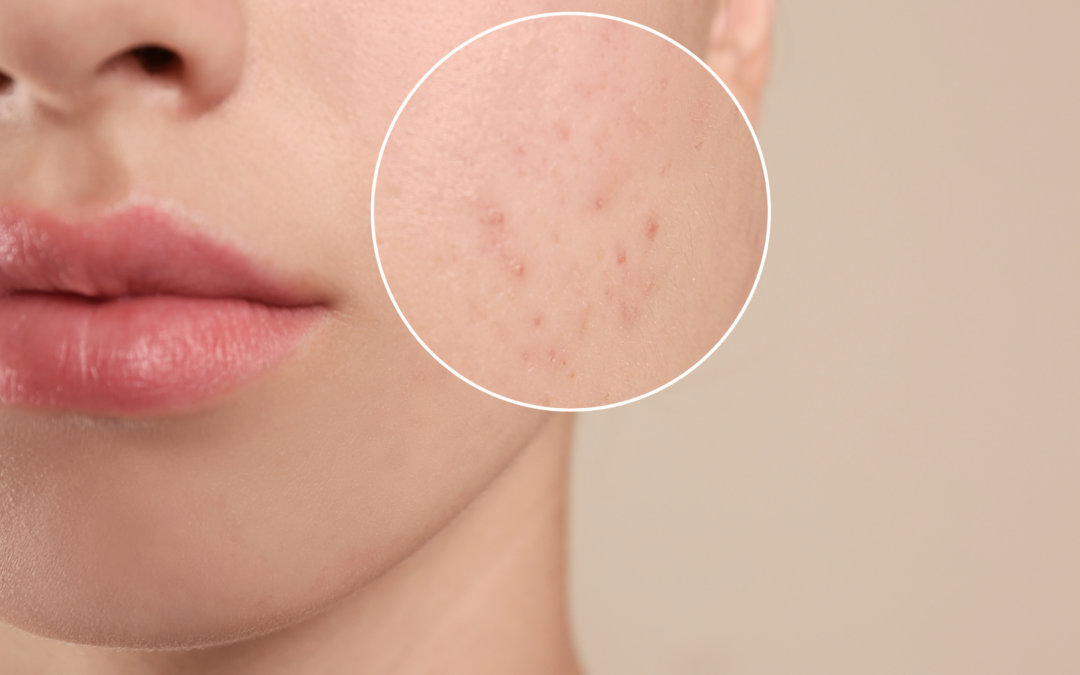Acne. Is there evidence you can improve acne with nutrition? It’s interesting, as I shift into perimenopause, I’ve noticed my teenage skin return. So fun. At the same time, with the emergence of puberty, my pre-teen and recently-turned-teenager are also starting to have breakouts. While I wish I could spare them, no matter what foods we eat, we’re all likely to have hormone-related skin care issues. That doesn’t mean that your diet has no impact on your skin health. There’s interesting research on the relationship between what we eat and acne I’ll break down in this post.
The Relationship: Nutrition and Acne
The development of acne can be blamed on four factors:
- Excessive oil secretion
- Skin bacteria (Cutibacterium acnes)
- Excessive buildup of skin cells in hair/oil glands
- Inflammation
The prevalence of acne is notably higher in Western populations compared to non-Western populations. While researchers haven’t found a definitive reason for the different, some speculate that it’s due to differences in dietary habits.
Do they help or hurt? The Role of Food and Nutrition in Acne
After scouring the research on this topic, I am certain of exactly one thing. There is no ONE food or food group to blame for acne. There are also no magic foods that will give you perfect, flawless skin. So much of the advice recommends avoiding specific foods or food groups to improve your skin, but we need to be careful of the unintended consequences of banning entire food groups.
For example, I recently worked with a teenage boy who wanted to gain weight for to improve performance in his sport. When we looked at his diet, dairy was a major contributor of calories in his diet. Complete elimination of dairy would be at odds with his performance and developmental goals. As with all changes to diet and nutrition, it’s rarely an all or nothing proposition.
Keeping in mind that it’s important to look at your diet as a whole before making any specific changes, we do have research that specific foods impact your skin health. Here’s the low down on the most-researched foods when it comes to acne:
Dairy

Research on the relationship between dairy and acne has mixed results. While some studies suggest a potential link, others find no significant association. Dairy, milk in particular, contains hormones like insulin-like growth factor-1 (IGF-1) and various androgen precursors. These hormones may contribute acne development. Other dairy foods, like cheese and yogurt, appear to be less correlated with causing acne. If you’re a milk drinker, work with a dietitian (hello!) to better understand whether cutting back makes sense for you.
Omega-3 Fatty Acids

Diets low in omega-3 fatty acids (fish fats) may also be associated with acne. Omega-3 fatty acids, found in fish, seaweed, and flaxseed have anti-inflammatory properties that may contribute to clear skin. Most studies evaluating omega-3 fats have used supplements, so there isn’t a lot of information regarding whole food sources . As a food-first kind of dietitian, I’d recommend increasing fish fats in the diet through whole foods. Two servings of fatty fish like tuna, salmon, or trout per week is a great starting point. Not a fish lover? You could add ground flaxseed, walnuts or other plant-rich omegas to your diet or add a supplement.
High-Glycemic Index Foods

Foods that are high in added sugars were the top food that people think contributed to acne (per my IG poll!).
Nutrition studies have actually shown a link between sugary foods and acne. But these were observational studies and this type of research cannot conclude that a food is causational. Based on the current research, we can’t blame acne on sugar.
Highly processed foods and foods high in added sugar are considered “high glycemic index foods.” These foods are classified this way because they can lead to spikes in blood sugar and insulin levels. In a research study, “Effects of Diet on Acne and Its Response to Treatment, participants who adhered to a low glycemic load diets had significant improvements in their acne.
Probiotics

I love the free samples that come when you purchase skin care products. I noticed in a recent lotion “freebie” that it included probiotics. If probiotics to improve our skin through lotion, could eating probiotics give you an inside out improvement for your skin? Supporting skin at the gut level with probiotics has been shown to improve acne outcomes. Studies that have evaluated probiotics used supplemental forms of bacteria, such as Lactobacillus and Bifidobacterium. A food-first approach focused on fermented foods like yogurt, kefir milk, and sauerkraut can add good gut bugs, too.
Putting This Into Food Patterns
As with most nutrition-related conversations, we haven’t found any magic bullet to cure acne. Diet alone will not be the answer. That said, maybe a few diet-related shifts are worth trying. What you choose to try and how you implement is up to you and based upon your personal starting point.
- If you drink a lot of milk, and you want to try making milk-based substitutions, there is evidence to back it.
- Add more probiotic-rich foods or a supplement? Even if acne doesn’t improve, you may still help support the health of your gut.
- If you aren’t eating fish, and you have a serving of salmon and tuna each week, you’ll reap the benefits of anti-inflammatory heart and brain benefits.
- Swapping in more whole foods and fewer chips and candy will add in nutrients and fiber and may have a positive impact on your skin.
All of these changes are a win for overall health beyond acne reduction.
We’d love support your skin’s health from the inside out. Get in touch with us if you’d like the one-on-one support or sign up for our custom meal planning service.

